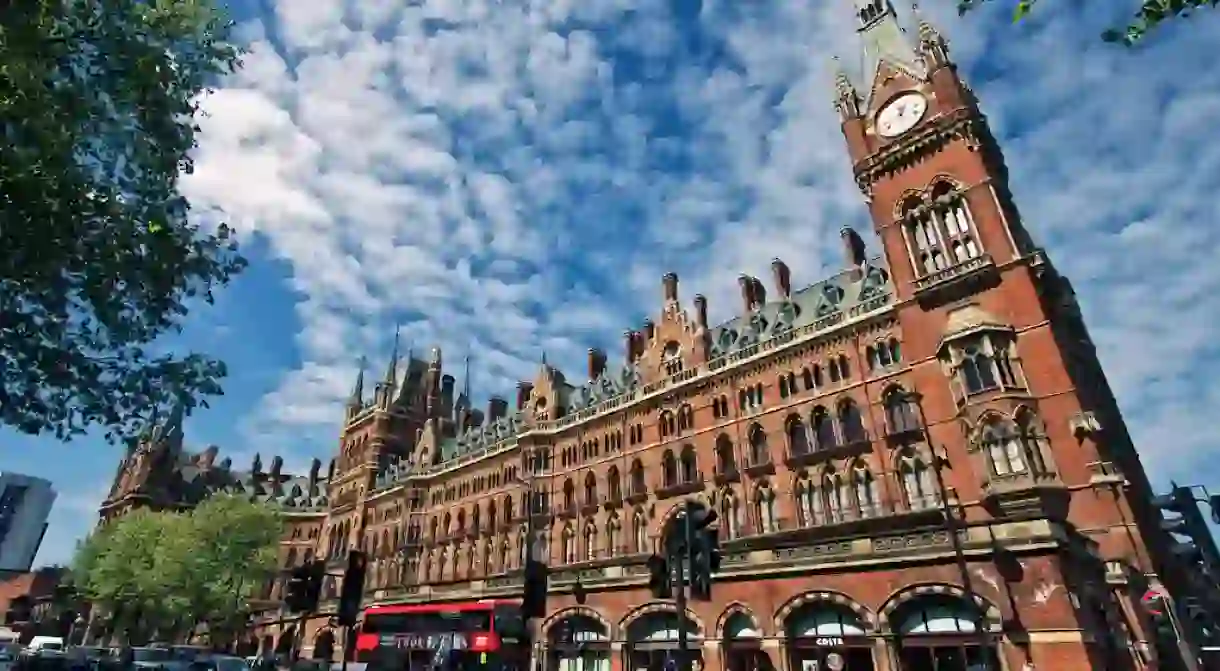Celebrating 150 Years of London's St Pancras Station

This year marks the 150th anniversary of London’s St Pancras International, one of the most remarkable train stations in the world. Consider this a historical homage to celebrate this momentous milestone in the station’s turbulent life, covering everything from clocks, bombs and lovers to strongly contested plans for demolition.
Inheriting its name from the surrounding area and its eponymous church, which was in turn named after a martyred child, St Pancras is as much a destination today as it is a station. The £800 million redevelopment of the complex, between 2004 and 2007, in preparation for the station’s international aspirations has done wonders for the area, where many people now come to eat, drink and shop. The station is perhaps most famous for the stunning single-span roof of its train shed, which inspired New York’s Grand Central Station, and the stunning Gothic revival hotel, originally called the Midland Grand Hotel, that adjoins the station to the southwest, designed by Victorian architect Sir George Gilbert Scott. But the station’s history is just as interesting as its architecture.

Below the platforms of the original station was an undercroft that was used to store all sorts of commodities that came into the capital via St Pancras. Most notably, three beer trains arrived at the station daily from Burton upon Trent to quench the capital’s thirst. The station’s redevelopment saw the abundance of support pillars in the undercroft removed to create a more open space now known as the Arcade, where luxury retail outlets have been incorporated into the arches of the original building, with the glass panels that enclose them staggered so as not to endanger the integrity of the original brickwork. Meanwhile, London and Continental Railways (LCR) went to the trouble of digging out the original station designs from the National Archives in Kew and sourcing the same bricks and stones used during the initial construction to enable an almost seamless restoration.
Preparations for the Eurostar, which came to St Pancras in 2007, marked the most significant restoration work undertaken on the station, but it certainly wasn’t the first. The station was damaged twice in air raids, with five bombs landing on or around the station in each World War. A zeppelin raid during World War I saw 20 killed and 33 injured when a bomb fell near the station’s booking office – now a stylish pub – where civilians had been sheltering. Then, during World War II, a bomb penetrated the train shed and significantly damaged platforms 3 and 4. Remarkably, the damage was repaired so quickly that the station was operational again the following week.

While some stories are remarkable for their contribution to the war effort, others are noteworthy for more sentimental reasons. The clock that watches over the platforms from the south end of the train shed isn’t the original. The whereabouts of which are currently said to be unknown – though it spent at least a few decades attached to a garden shed in the small rural village of Thurgarton in Nottinghamshire. Why, you may ask? Well, during the 1970s, after British Rail had agreed to sell the clock to an American collector for £250,000, workmen charged with the removal managed to drop it, shattering the tremendous timepiece and rendering it worthless. At least that was the view of the American collector, who was no longer prepared to pay for it, and British Rail, which was allegedly poised to dispose of it. Roland Hoggard, a railway worker and clock enthusiast, disagreed. He adopted the clock and painstakingly restored it to its former glory. Hoggard’s efforts were so successful that LCR modelled the new clock in the modern St Pancras station on Hoggard’s scrupulously restored original.
In the old days the clock served as a meeting point for travellers who had no means of contacting each other upon arrival at the station. But nowadays, between the advent of mobile phones and the arrival of English sculptor Paul Day’s towering Meeting Place statue, the clock has lost its former status. The statue depicts two lovers and is modelled on an embrace between Paul and his French wife Catherine, intended to depict the Anglo-French relationship and emphasise the role of St Pancras as a bridge between the two countries. The enormity of the lovers is matched only by the intrigue of the high-relief frieze that encircles the base of the statue and represents various chapters of St Pancras’s history. Included on the frieze are depictions of the construction of the railways, the area’s days as a red light district, trains full of soldiers arriving back from the First World War and setting off for the second, commuters packed into trains like sardines and a controversial portrayal of what appears to represent a dissuaded suicide attempt.

Despite St Pancras twice sustaining damage during German air raids, it was the British themselves who posed the greatest threat to the station’s existence. First the London Society suggested closing the station in 1921, but nothing came of it. Ironically it was British Rail’s proposals in 1966 that proved the greatest existential threat to the rail station. The transport company wanted to combine the neighbouring St Pancras and King’s Cross stations, a plan which involved demolishing both historic stations to make way for a new one. These plans were foiled by the efforts of architectural historian Nikolaus Pevsner and poet laureate John Betjeman, who spearheaded a public campaign to save the stations and secured Grade-I listed status for St Pancras. In honour of the man who saved St Pancras, a statue of John Betjeman gazing up at the magnificent roof can be found near the Meeting Place on the station’s Grand Terrace.

Enjoy reading this? Check out these fun facts about St Pancras station and its neighbouring rail rival King’s Cross.













